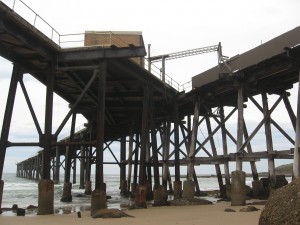I’ve never understood the urge to cheer when something is destroyed, however spectacular the destruction might be. My feeling is that objects embody effort, skill and time – and sometimes a great deal of blood, sweat and tears. All that is worthy of respect and consideration, at least. There are some exceptions to this of course; not least the toppling of the statues of tyrants. The golden likeness of the brutal Enver Hoxha of Albania is a good example.
The demolition of the towering Port Kembla copper smelter chimney last week produced whoops and claps from the audience assembled to watch the structure come crashing down. Admittedly I didn’t grow up near what the Daily Telegraph (20 February 2014) referred to as the ‘infamous’ tower. My washing was never spoiled by it, nor did I breathe in its exhaust. Perhaps some of those who cheered were really glad to see the thing go because of the bad memories it triggered and what it represented – though it hadn’t been operational since 2003. Perhaps the chimney was something of a tyrant in its own right.
But reports also suggested there were those who shed a tear. Some worked at the place, others considered it a defining landmark. One man’s father helped build the stack and was too upset to see it destroyed. The chimney was just under 50 years old; built in 1965 it symbolised the post-war industrial development of Port Kembla. The copper smelter gave many immigrants their first permanent job. Indeed for a community that now suffers from chronic unemployment it was a very obvious reminder of a productive, even heroic, past.
‘A relic’s worth’, as the writer David Lowenthal points out, depends in part ‘on what use its serves’. If the retention of the chimney serves no purpose as a reminder, an icon, a focal point of community identity then I suppose its loss does not matter. Lowenthal goes on to say ‘everything surviving from the past has some value which is forfeited unless it is preserved’. I’m not sure, however, if that value or the depth of community feeling was much assessed in Port Kembla.
Retaining the obsolete industrial monoliths of the 20th century is fraught. They are often hard to re-use and expensive to maintain. Some are contaminated, though in the case of the Port Kembla chimney reports suggest that the asbestos had been removed. Size and retention cost are the reasons that the 60 year old Garden Island hammer head crane will be dismantled. Its removal will profoundly change the skyline of Sydney Harbour, cutting the last significant focal link to that waterway’s industrial past.
But at Catherine Hill Bay – a small State Heritage Listed mining settlement on the NSW’s central coast – the case for retaining the massive coal loading jetty may just have become stronger. It was not included in the Heritage Listing and was slated for demolition for the same reasons as Sydney Harbour’s hammer head crane. However, a fire in late 2013 that destroyed other heritage sites in the 130 year old town left most of the jetty intact. The local Progress Association and Lake Macquarie City Council hope the owner, Lake Coal, will fund its restoration. It is unlikely that any reuse can be found for the structure – it is too high to be used as a fishing wharf. But it has ‘symbolic’ value as a link to the origins of the settlement. And as one of the last of the long jetties that once extended like fingers into the sea from Byron Bay to the Illawarra it surely has state significance. Maybe the case can be made again as plans proceed to build the large subdivision just south of the original settlement. Maybe funds might be found through that development. For the jetty would be clearest reminder of Catherine Hill’s historical reason for being.

There is precious little industrial heritage left on the NSW coast. The phenomenon of sea change has so transformed towns that it is hard to imagine our relationship with the coast before the advent of surfing and mass holidays. Structures like the Catherine Hill jetty help offset that collective amnesia.

